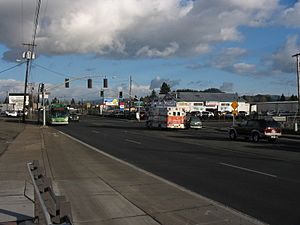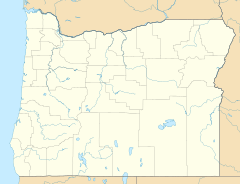Glenwood, Lane County, Oregon facts for kids
Quick facts for kids
Glenwood, Oregon
|
|
|---|---|

An EmX bus approaches a station in Glenwood, along Franklin Boulevard.
|
|
| Country | United States |
| State | Oregon |
| County | Lane |
| Platted | 1888 |
| Elevation | 440 ft (130 m) |
| Time zone | UTC-8 (Pacific (PST)) |
| • Summer (DST) | UTC-7 (PDT) |
| ZIP code |
97403
|
| Area code(s) | 458 and 541 |
| GNIS feature ID | 1136321 |
Glenwood is a small community in Lane County, Oregon, United States. It's not an official city, but an unincorporated community. You can find it between the University of Oregon in Eugene and downtown Springfield. It sits along Franklin Boulevard, which used to be a major road called the Pacific Highway.
Glenwood is a mix of homes and businesses. Because it's not a city, it has often attracted people who like to try new things and live in their own way. For many years, people have wanted to improve Glenwood, especially the areas near the river.
Contents
History of Glenwood
The first settler in Glenwood was Charles B. Sweet. He claimed land there in 1851 under a special law called the Donation Land Claim Act. This law allowed people to get land for free if they settled on it.
In 1888, Glenwood was officially planned out and named Glenwood Park. Henderson Avenue was the main north-south street. The Springfield Wagon Road ran east-west, and another road, now Franklin Boulevard, was to the north.
Early Challenges and Auto Camps
For a long time, Glenwood didn't grow much because of floods from the Willamette River. But its location along the Pacific Highway was perfect for "auto camps." These were places where travelers could park their cars and stay overnight. Later, these auto camps were replaced by mobile home parks.
In 2004, the people of Springfield voted to make Glenwood an urban renewal district. This means they wanted to improve and develop the area.
African-American History in Glenwood
In the past, it was hard for Black residents to buy or rent homes in Eugene. So, many moved to county land along the Willamette River. Glenwood became one of these places.
In 1948, many Black families had to move from a tent city in Eugene because a new bridge was being built. About twelve of these families found homes in Glenwood. By 1950, a part of Glenwood called "Skunk Hollow" had 16 Black residents. Many of them worked for the railroad.
Glenwood also had a church that was mostly attended by Black residents. Arthur J. Shankle, a construction worker, became a reverend and, with his wife Luvenia, started the Bethel Temple. They bought the church property and built a new church on Brooklyn Street. Today, this building is a shelter for people experiencing homelessness, called the Shankle Safe Haven. The Bethel Temple church moved to Eugene in 1995 and is still active.
Geography of Glenwood
The Willamette River forms the northern and eastern edges of Glenwood. The western and southern edges are bordered by Interstate 5 (I-5), a major highway.
A part of the Willamette River that got cut off, called Glenwood Slough, flows through the community. Augusta Creek, which comes from Moon Mountain in Eugene, used to connect to Glenwood Slough.
Community Life
In 1940, about 1,800 people lived in Glenwood. By 2006, the population was around 1,300. The average income in Glenwood in 2006 was about $23,000, which was lower than the county average of $37,000.
Economy and Businesses
Glenwood used to be a farming area. In the 1940s, it had a large bean processing yard. It also had three grocery stores, one of which was very successful. That market unfortunately burned down in 1950.
Williams' Bakery moved to Glenwood after its old location was needed for the University of Oregon's Matthew Knight Arena.
Parks and Recreation in Glenwood
James Park was the very first park created by the Willamalane Park and Recreation District in 1944. It's a great place for outdoor activities.
Education in Glenwood
Glenwood School was a four-room elementary school built in 1935. It closed in the 1960s. Today, students living in Glenwood attend public schools in Eugene.
Infrastructure and Services
Glenwood has an important facility called the Glenwood Central Receiving Station. This is where trash and recycling are collected. From here, the materials are taken to a landfill for disposal.
Laurel Grove Cemetery is a historic pioneer cemetery located in Glenwood. The first burial there was in 1855. Many important people are buried here, including Isaac Briggs, who founded Springfield, and Charnel Mulligan, who helped found Eugene.
Transportation in Glenwood
Rail Connections
The Union Pacific (UP) Cascade Line, a railroad track, runs through Glenwood. There's a special track setup called the Springfield Junction wye in Glenwood. This is where the UP's Cascade Line and the Siskiyou Line split off from each other. They don't join up again until Black Butte, California.
Bus Services
Glenwood is served by the Emerald Express (EmX) bus rapid transit system. This is a fast and efficient bus service run by the Lane Transit District (LTD). LTD's bus garages and offices are also located in Glenwood.



